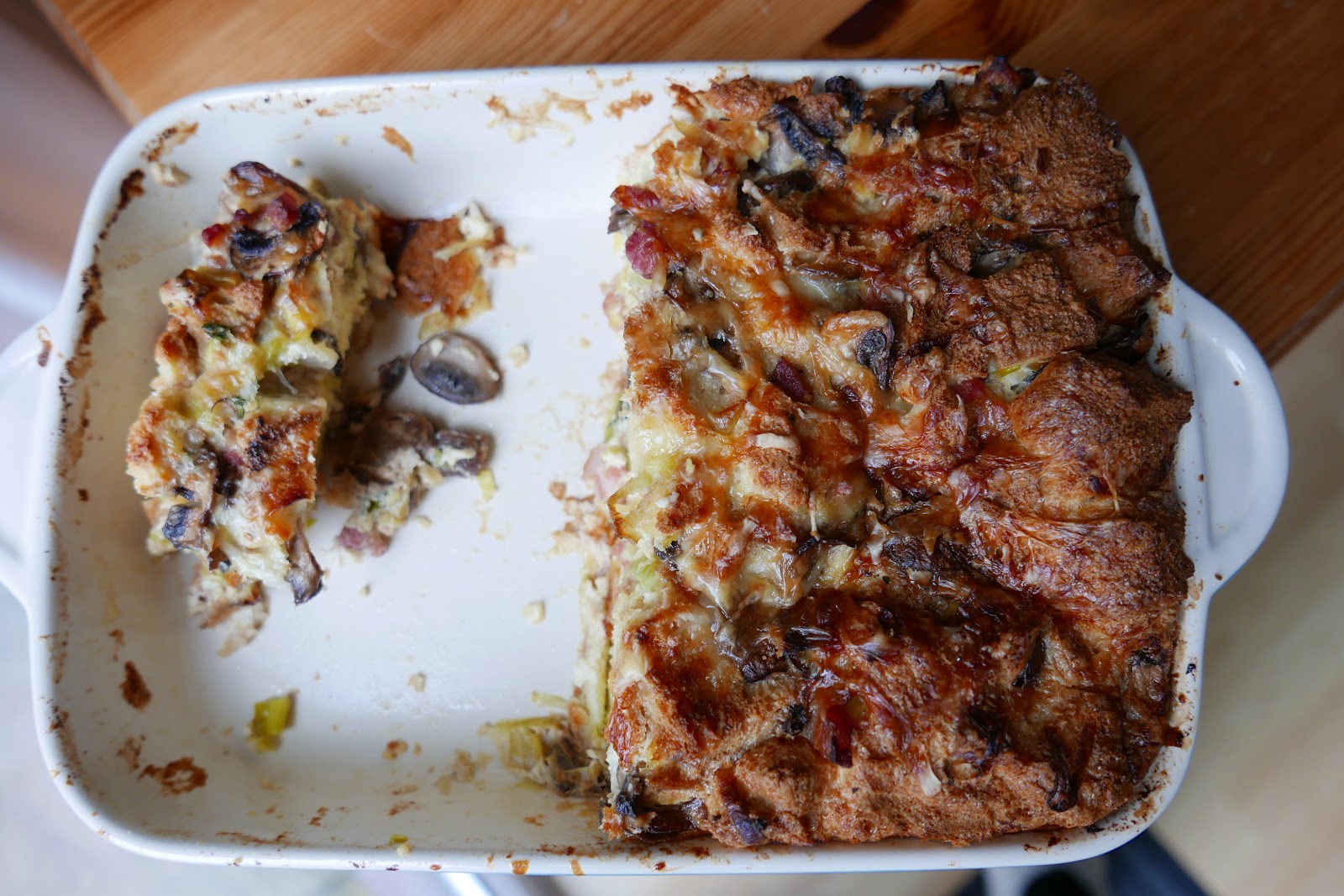
You’ll need:
Unsalted butter, for the baking dish
8 oz/225g country-style bread, preferably day-old
8 oz/225g thick cut bacon, cut into 1/4-inch pieces
2 small or 1 large/110g leek, white and light green parts sliced 1.2 inch/12mm thick and rinsed (I used green onions)
2 Tbsp olive oil, as needed
1 lb/455g mixed wild mushrooms, sliced 1/4 inch thick (I used a mix of shiitake and cremini)
1/2 cup grated Parmesan cheese
1/3 cup flat leaf parsley, chopped
2 tsp fresh thyme leaves
1/2 tsp sea salt
6 large eggs
2 cups/480 ml whole milk
1 cup/240 ml heavy cream
1/4 cup/25 g grated Gruyere, Comte, or other firm cheese
Ground black pepper

Directions
Preheat the oven to 350 degrees F/180 degrees C.
Butter inside surfaces of a 9-inch/23 cm square baking dish with at least 2-inch/5cm sides.
Cut the bread into 1-inch/2.5 cm cubes.
Spread them out on a baking sheet and place in the oven to toast for a few minutes, until lightly toasted.
Set aside.
In a skillet over medium-high heat, cook the bacon until slightly crisped but not yet bully browned.
Transfer to a large bowl and pour off all but 2 Tbsp of fat from the skillet.
Add the leeks to the skillet and cook over medium-high heat, stirring often, until soft, 3 to 5 minutes.
Transfer to the bowl with the bacon.
If the pan looks dry, swirl in 1 Tbsp of the olive oil.
Add about half of the mushrooms and saute, stirring occasionally, until crisp and lightly browned in a few places, 3 to 5 minutes.
Transfer the mushrooms to the bowl and cook the remaining mushrooms, adding as much of the remaining 1 Tbsp of oil to the skillet as needed.
Transfer to the bowl and let cool.
Add the cheese, parsley, thyme, and salt to the cooked mushroom mixture and mix well.
In another bowl, whisk together the eggs, milk, and cream until well blended.
Pour over the mushroom mixture and stir to combine.
Gently mix in the toasted bread cubes.
Carefully pour the bread mixture into the prepared baking dish.
The custard should come right up to the top but not cover the highest cubes of bread.
(If you have extra, fill a buttered ramekin and make an additional, smaller bread pudding (note from Sarah: I had extra)).
Scatter the additional cheese evenly over the pudding and grind a light dusting of pepper on top.
Bake until the custard is no longer runny but still a bit wobbly in the center, 40 minutes to 1 hour (and about 25 minutes for a smaller ramekin).
It will continue to cook as it sits before serving.
Serve the bread pudding hot or at room temperature.
Any leftovers can be stored, well wrapped, in the refrigerator for up to 3 days and reheated, covered with aluminum foil, in a 350 degree F/180 degree C oven.

- http://casayellow.com/2017/04/19/savory-bread-pudding-with-mushrooms-bacon/
OR:
- Savory Vegetable Bread Pudding From 'The Beekman 1802 Heirloom Vegetable Cookbook' | Serious Eats:






















